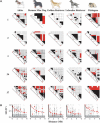Extensive and breed-specific linkage disequilibrium in Canis familiaris
- PMID: 15545498
- PMCID: PMC534662
- DOI: 10.1101/gr.3147604
Extensive and breed-specific linkage disequilibrium in Canis familiaris
Abstract
The 156 breeds of registered dogs in the United States offer a unique opportunity to map genes important in disease susceptibility, morphology, and behavior. Linkage disequilibrium (LD) is of current interest for its application in whole genome association mapping, since the extent of LD determines the feasibility of such studies. We have measured LD at five genomic intervals, each 5 Mb in length and composed of five clusters of sequence variants spaced 800 kb-1.6 Mb apart. These intervals are located on canine chromosomes 1, 2, 3, 34, and 37, and none is under obvious selective pressure. Approximately 20 unrelated dogs were assayed from each of five breeds: Akita, Bernese Mountain Dog, Golden Retriever, Labrador Retriever, and Pekingese. At each genomic interval, SNPs and indels were discovered and typed by resequencing. Strikingly, LD in canines is much more extensive than in humans: D' falls to 0.5 at 400-700 kb in Golden Retriever and Labrador Retriever, 2.4 Mb in Akita, and 3-3.2 Mb in Bernese Mountain Dog and Pekingese. LD in dog breeds is up to 100x more extensive than in humans, suggesting that a correspondingly smaller number of markers will be required for association mapping studies in dogs compared to humans. We also report low haplotype diversity within regions of high LD, with 80% of chromosomes in a breed carrying two to four haplotypes, as well as a high degree of haplotype sharing among breeds.
Figures



Similar articles
-
Extent of linkage disequilibrium in large-breed dogs: chromosomal and breed variation.Mamm Genome. 2013 Oct;24(9-10):409-15. doi: 10.1007/s00335-013-9474-y. Epub 2013 Sep 6. Mamm Genome. 2013. PMID: 24062056
-
Complex high-resolution linkage disequilibrium and haplotype patterns of single-nucleotide polymorphisms in 2.5 Mb of sequence on human chromosome 21.Genomics. 2001 Nov;78(1-2):64-72. doi: 10.1006/geno.2001.6646. Genomics. 2001. PMID: 11707074
-
Assessment of the functionality of genome-wide canine SNP arrays and implications for canine disease association studies.Anim Genet. 2011 Apr;42(2):181-90. doi: 10.1111/j.1365-2052.2010.02132.x. Epub 2010 Nov 11. Anim Genet. 2011. PMID: 21070295
-
Dog star rising: the canine genetic system.Nat Rev Genet. 2004 Dec;5(12):900-10. doi: 10.1038/nrg1492. Nat Rev Genet. 2004. PMID: 15573122 Review.
-
The canine genome.Genome Res. 2005 Dec;15(12):1706-16. doi: 10.1101/gr.3736605. Genome Res. 2005. PMID: 16339369 Review.
Cited by
-
Breed-predispositions to cancer in pedigree dogs.ISRN Vet Sci. 2013 Jan 17;2013:941275. doi: 10.1155/2013/941275. Print 2013. ISRN Vet Sci. 2013. PMID: 23738139 Free PMC article.
-
Body size, inbreeding, and lifespan in domestic dogs.Conserv Genet. 2020 Feb;21(1):137-148. doi: 10.1007/s10592-019-01240-x. Epub 2019 Dec 5. Conserv Genet. 2020. PMID: 32607099 Free PMC article.
-
Identification of loci associated with conception rate in primiparous Holstein cows.BMC Genomics. 2019 Nov 12;20(1):840. doi: 10.1186/s12864-019-6203-2. BMC Genomics. 2019. PMID: 31718557 Free PMC article.
-
Genetic Diversity and Signatures of Selection in 15 Chinese Indigenous Dog Breeds Revealed by Genome-Wide SNPs.Front Genet. 2019 Nov 15;10:1174. doi: 10.3389/fgene.2019.01174. eCollection 2019. Front Genet. 2019. PMID: 31803243 Free PMC article.
-
Canine morphology: hunting for genes and tracking mutations.PLoS Biol. 2010 Mar 2;8(3):e1000310. doi: 10.1371/journal.pbio.1000310. PLoS Biol. 2010. PMID: 20209140 Free PMC article.
References
-
- The American Kennel Club (AKC). 1998. The complete dog book. Howell Book House, New York.
-
- Breen, M., Thomas, R., Binns, M.M., Carter, N.P., and Langford, C.F. 1999. Reciprocal chromosome painting reveals detailed regions of conserved synteny between the karyotypes of the domestic dog (Canis familiaris) and human. Genomics 61: 145-155. - PubMed
Web site references
-
- http://www.genome.ucsc.edu/; UCSC Genome Browser.
-
- http://www.AKC.org; American Kennel Club.
-
- http://www.ncbi.nlm.nih.gov/; NCBI, National Center for Biotechnology Information.
-
- http://www.repeatmasker.org/; RepeatMasker online tool.
-
- http://www-genome.wi.mit.edu/cgi-bin/primer/primer3_www.cgi; Primer3 online tool.
Publication types
MeSH terms
Grants and funding
LinkOut - more resources
Full Text Sources
Other Literature Sources
Research Materials
Miscellaneous
